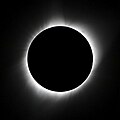| Total eclipse | |
| Gamma | 0.4188 |
|---|---|
| Magnitude | 1.0464 |
| Maximum eclipse | |
| Duration | 226 s (3 min 46 s) |
| Coordinates | 20°42′N140°00′E / 20.7°N 140°E |
| Max. width of band | 169 km (105 mi) |
| Times (UTC) | |
| Greatest eclipse | 1:58:56 |
| References | |
| Saros | 139 (28 of 71) |
| Catalog # (SE5000) | 9482 |
A total solar eclipse occurred at the Moon's ascending node of orbit between Thursday, March 17 and Friday, March 18, 1988, [1] with a magnitude of 1.0464. A solar eclipse occurs when the Moon passes between Earth and the Sun, thereby totally or partly obscuring the image of the Sun for a viewer on Earth. A total solar eclipse occurs when the Moon's apparent diameter is larger than the Sun's, blocking all direct sunlight, turning day into darkness. Totality occurs in a narrow path across Earth's surface, with the partial solar eclipse visible over a surrounding region thousands of kilometres wide. Occurring only 1.1 days after perigee (on March 16, 1988, at 20:30 UTC), the Moon's apparent diameter was larger. [2]
Contents
- Observation
- Eclipse details
- Eclipse season
- Related eclipses
- Eclipses in 1988
- Metonic
- Tzolkinex
- Half-Saros
- Tritos
- Solar Saros 139
- Inex
- Triad
- Solar eclipses of 1986–1989
- Saros 139
- Metonic series
- Tritos series
- Inex series
- References
- External links
Totality was visible in Indonesia and southern Philippines. A partial eclipse was visible for parts of South Asia, Southeast Asia, East Asia, Northeast Asia, Australia, and Alaska.







































































































